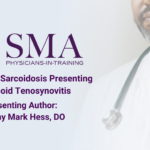Abstract | May 6, 2021
Uncontrolled Sarcoidosis Presenting as Sarcoid Tenosynovitis
Learning Objectives
- Know common and uncommon manifestations of sarcoidosis;
- Understand appropriate work-up, including rheumatologic and endocrinological approach, to hand joint pain and inflammation.
Introduction:
Sarcoidosis, an idiopathic inflammatory disease, has a prevalence of 1-40 cases per 100,000 with a higher number of cases reported in Nordic countries and African Americans. The most common constitutional manifestations include fever, night sweats, weight loss, and fatigue. The most common organs involved are lungs (>90%), liver (50-80%), spleen (40-80%), skin (25%), nervous system (10%), and heart (5%) however only 22 cases of sarcoid tenosynovitis have been reported.
Case:
A 57-year-old African American female with type 2 diabetes mellitus, obesity, obstructive sleep apnea, hypertension, atrial fibrillation, complete heart block post pacemaker placement, and pulmonary sarcoidosis with chronic steroid use but no immunomodulators presented with worsening shortness of breath and bilateral phalangeal swelling with intermittent pain for 4 years, but now unable to wear rings. Physical exam showed soft tissue hypertrophy of bilateral hands with decreased flexion at proximal interphalangeal joints and no macroglossia. Concern initially was for acromegaly as laboratory results showed a C-reactive protein elevated at 2.76 mg/dL, mildly elevated insulin-like growth factor (IGF-1) at 177 ng/dL, negative rheumatoid factor, and a negative anti-cyclic citrullinated peptide antibody. Bilateral hand x-rays showed degenerative changes. Patient was referred to rheumatology who pursued workup for acromegaly, checking repeat IGF-1 and growth hormone (GH), which were normal, and referred to endocrinology. Endocrinology, after reviewing old pictures without facial changes, normal IGF-1, GH and anterior pituitary function, believing the cause to be sarcoid tenosynovitis. Gold standard magnetic resonance imaging was unable to be obtained due to an incompatible pacemaker and positron emission tomography (PET) scan showed multiple areas of hypermetabolism.
Diagnosis:
Uncontrolled sarcoidosis with sarcoid tenosynovitis .
Management:
This case represents a rare complication of sarcoidosis. Diagnosis is supported by clinical history, rule-out of more common etiologies, and PET imaging exhibiting active disease, though hands were not directly visualized. Patient now plans to pursue more directed therapies for her sarcoidosis given poor control on current corticosteroid regimen and worsening disease manifestations. Further directed hand imaging could be useful but would not change management at this time.

